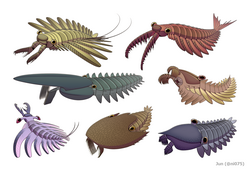아노말로카리스과
보이기
|
| ||
|---|---|---|
 Anomalocaris canadensis | ||
 Lenisicaris lupata | ||
| 생물 분류ℹ️ | ||
| 역: | 진핵생물역 | |
| 계: | 동물계 | |
| 문: | 절지동물문 | |
| 강: | †공하강 | |
| 목: | †방사치목 | |
| 과: | †아노말로카리스과 Raymond, 1935 | |
| 속 | ||
|
| ||
아노말로카리스과(Anomalocarididae)[derivation 1]는 절지동물 줄기군의 하나인 방사치목의 멸종한 동물 가운데 한 과로 캄브리아기에 출현했다.[1][2]
1990년대~2010년대 초까지만 하더라도, 아노말로카리스과에 모든 방사치류 생물종들이 분류되어 있었다. 따라서 일반 영칭인 'anomalocaridid'는 모든 방사치류를 일컫는 것에 해당했다.[3] 2014년 Vinther 등이 개정한 이후에는 더 이상 그렇게 해당되지 않는데,[1] 그 이유는 아노말로카리스과는 그 이후로 근연인 몇몇 속만을 포함하여 아노말로카리스속으로 제한을 두었기 때문이다. Wu 등은 2021년에 아노말로카리스속[a]과 레니시카리스를 아노말로카리스과의 일원으로 분류시킨 반면,[2] 파라아노말로카리스의 경우 일부 연구에서도 확실치 않게 분류되어 있다.[4][5][6] 그 이후로, ''A.'' saron와 같이 '아노말로카리스속'에 속하는 다른 종들이 발견되었는데, 독자 속으로 재배속시켰다.[b]
아노말로카리스과는 암플렉토벨루아, 리라라팍스 등이 속한 암플렉토벨루아과와 닮은 점이 있지만 비대하지 않은 첫 번째 원위 내돌기[2] 및 삼방사형 구주의 존재로 인해 구별되는 점도 있다.[8] 후르디아과 및 타미시오카리스과와 비교해 볼 때, 이 두 과는 많은 특징을 공유하며[c] 다중 계통분석에서 한 분기군을 형성한다.[1][4][14][5][9]
같이 보기
[편집]각주
[편집]내용주
[편집]- ↑ 그리스어 아노말로스 ἀνώμαλος anomalos와 카리스 καρίς karis (gen.: καρίδος)를 조합한 신라틴어로 "이상한 새우"라는 뜻이다. "아노말로카리드 Anomalocarid" 도 같은 의미로 널리 쓰이지만 단어 끝에 "id" 가 두 번 붙는 것이 정확한 형태로, 그 이유는 Xianguang, H.; Bergström, J.; Jie, Y. (2006). “Distinguishing anomalocaridids from arthropods and priapulids”. Geological Journal 41 (3–4): 259. doi:10.1002/gj.1050.에 제시되어 있다.
참고주
[편집]- ↑ 가 나 다 Vinther, Jakob; Stein, Martin; Longrich, Nicholas R.; Harper, David A. T. (2014). “A suspension-feeding anomalocarid from the Early Cambrian”. 《Nature》 (영어) 507 (7493): 496–499. doi:10.1038/nature13010. hdl:1983/88f89453-e81f-4767-a74d-1794c33e6b34. ISSN 1476-4687. PMID 24670770. S2CID 205237459.
- ↑ 가 나 다 Wu, Yu; Ma, Jiaxin; Lin, Weiliang; Sun, Ao; Zhang, Xingliang; Fu, Dongjing (2021년 5월 1일). “New anomalocaridids (Panarthropoda: Radiodonta) from the lower Cambrian Chengjiang Lagerstätte: Biostratigraphic and paleobiogeographic implications”. 《Palaeogeography, Palaeoclimatology, Palaeoecology》 (영어) 569 (110333). doi:10.1016/j.palaeo.2021.110333. ISSN 0031-0182. S2CID 233565727.
- ↑ Edgecombe, Gregory D. (2010년 3월 1일). “Arthropod phylogeny: An overview from the perspectives of morphology, molecular data and the fossil record”. 《Arthropod Structure & Development》. Fossil Record and Phylogeny of the Arthropoda (영어) 39 (2): 74–87. doi:10.1016/j.asd.2009.10.002. ISSN 1467-8039. PMID 19854297.
- ↑ 가 나 Van Roy, Peter; Daley, Allison C.; Briggs, Derek E. G. (2015). “Anomalocaridid trunk limb homology revealed by a giant filter-feeder with paired flaps”. 《Nature》 (영어) 522 (7554): 77–80. doi:10.1038/nature14256. ISSN 1476-4687. PMID 25762145. S2CID 205242881.
- ↑ 가 나 Liu, Jianni; Lerosey-Aubril, Rudy; Steiner, Michael; Dunlop, Jason A; Shu, Degan; Paterson, John R (2018년 11월 1일). “Origin of raptorial feeding in juvenile euarthropods revealed by a Cambrian radiodontan”. 《National Science Review》 5 (6): 863–869. doi:10.1093/nsr/nwy057. ISSN 2095-5138.
- ↑ Jiao, De-guang; Pates, Stephen; Lerosey-Aubril, Rudy; Ortega-Hernandez, Javier; Yang, Jie; Lan, Tian; Zhang (2021). “The endemic radiodonts of the Cambrian Stage 4 Guanshan biota of South China”. 《Acta Palaeontologica Polonica》 (영어) 66. doi:10.4202/app.00870.2020. ISSN 0567-7920.
- ↑ Zeng, Han; Zhao, Fangchen; Zhu, Maoyan (2022년 9월 7일). “Innovatiocaris, a complete radiodont from the early Cambrian Chengjiang Lagerstätte and its implications for the phylogeny of Radiodonta”. 《Journal of the Geological Society》 180. doi:10.1144/jgs2021-164. ISSN 0016-7649. S2CID 252147346.
- ↑ Daley, Allison C.; Bergström, Jan (2012년 6월 1일). “The oral cone of Anomalocaris is not a classic peytoia”. 《Naturwissenschaften》 (영어) 99 (6): 501–504. doi:10.1007/s00114-012-0910-8. ISSN 1432-1904. PMID 22476406. S2CID 2042726.
- ↑ 가 나 다 Moysiuk, Joseph; Caron, Jean-Bernard (2021). “Exceptional multifunctionality in the feeding apparatus of a mid-Cambrian radiodont”. 《Paleobiology》 (영어) 47 (4): 704–724. doi:10.1017/pab.2021.19. ISSN 0094-8373. S2CID 236552819.
- ↑ 가 나 다 Chen, Jun-yuan; Ramsköld, Lars; Zhou, Gui-qing (1994년 5월 27일). “Evidence for Monophyly and Arthropod Affinity of Cambrian Giant Predators”. 《Science》 264 (5163): 1304–1308. doi:10.1126/science.264.5163.1304. PMID 17780848. S2CID 1913482.
- ↑ 가 나 Daley, Allison C.; Edgecombe, Gregory D. (2014). “Morphology of Anomalocaris canadensis from the Burgess Shale”. 《Journal of Paleontology》 (영어) 88 (1): 68–91. doi:10.1666/13-067. ISSN 0022-3360. S2CID 86683798.
- ↑ 가 나 Moysiuk, J.; Caron, J.-B. (2019년 8월 14일). “A new hurdiid radiodont from the Burgess Shale evinces the exploitation of Cambrian infaunal food sources”. 《Proceedings of the Royal Society B: Biological Sciences》 286 (1908): 20191079. doi:10.1098/rspb.2019.1079. PMC 6710600. PMID 31362637.
- ↑ Cong, Peiyun; Daley, Allison C.; Edgecombe, Gregory D.; Hou, Xianguang (2017년 8월 30일). “The functional head of the Cambrian radiodontan (stem-group Euarthropoda) Amplectobelua symbrachiata”. 《BMC Evolutionary Biology》 17 (1): 208. doi:10.1186/s12862-017-1049-1. ISSN 1471-2148. PMC 5577670. PMID 28854872.
- ↑ 가 나 Lerosey-Aubril, Rudy; Pates, Stephen (2018년 9월 14일). “New suspension-feeding radiodont suggests evolution of microplanktivory in Cambrian macronekton”. 《Nature Communications》 (영어) 9 (1): 3774. doi:10.1038/s41467-018-06229-7. ISSN 2041-1723. PMC 6138677. PMID 30218075.

